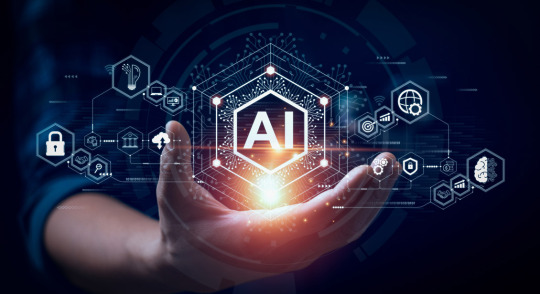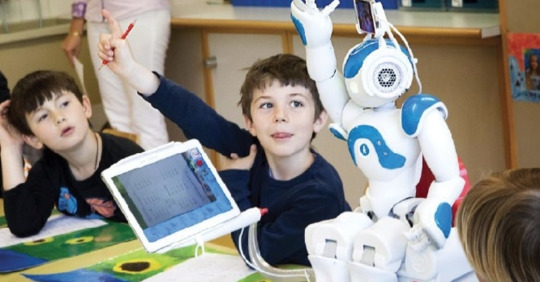Don't wanna be here? Send us removal request.
Text
The Use of AI in Early Education and Its Impact on Children at an Early Age
This blog examines how AI is used in early childhood education, its benefits, potential concerns, and how parents and teachers can use it wisely.
Introduction We now live in a world where artificial intelligence (AI) is no longer just a fantasy. It is changing how we live, work, and learn. One of the most exciting developments is using AI in early childhood education. From smart tutors and adaptive learning apps to speech recognition and personalized content, AI is changing how our youngest learners engage with knowledge. But how early is too early? And what impact does AI have on developing minds?
In this blog, we examine how AI influences early education, the benefits and challenges it brings, and what this means for future learners.

How Is AI Used in Early Childhood Education? AI is being incorporated into early education in various creative and effective ways. Here are some main applications:
Personalized Learning Apps AI-powered platforms like Khan Academy Kids, ABCmouse, and Osmo adjust to a child’s learning pace and style. These apps can recommend content, track progress, and automatically change difficulty based on performance.
Speech Recognition & Language Learning Tools like Google Read Along and Duolingo ABC use AI to help kids with pronunciation, vocabulary, and reading skills. They provide immediate feedback, making the learning experience feel engaging and personal.
Gamified Learning and Engagement AI-driven games help keep young learners interested while they solve puzzles, recognize patterns, or practice basic math, all while receiving personalized assistance based on their behavior.
Early Diagnosis of Learning Disabilities Some AI tools can spot early signs of learning issues like dyslexia, speech delays, or ADHD. This enables teachers and parents to intervene early with the right support.
AI Assistants in the Classroom Robots and voice-based assistants, like Miko or smart speakers, are being used in classrooms to answer student questions, tell stories, and encourage interaction.
Positive Impacts of AI on Young Children When designed thoughtfully and used ethically, AI can greatly benefit early education:
Personalized Learning Journeys Each child learns in their way. AI can customize content to fit individual strengths and weaknesses, making learning easier and more rewarding.
Improved Engagement and Motivation Interactive content keeps kids curious and motivated, especially in home-based or remote settings.
Real-time Feedback Children do not have to wait for a teacher’s input. AI tools can instantly correct their mistakes and guide them along.
Early Intervention AI helps identify learning barriers early, allowing for prompt action before issues worsen.

Challenges and Concerns While the benefits are encouraging, there are some issues we should consider:
Screen Time Overload Too much screen time, even for educational content, can lead to shorter attention spans and may affect social development.
Data Privacy Children's data must be handled carefully. Many parents worry about what information is collected and how it is used.
Overreliance on Technology Children still need human interaction to build empathy, social skills, and critical thinking — areas where AI cannot currently replace human input.
Teacher Displacement Myths AI is not a substitute for teachers. It is a tool to support and enhance what educators already do well.
The Role of Parents and Teachers AI can be a valuable assistant, but human guidance is essential. Parents and teachers must:
Guide the use of AI tools
Set time limits
Choose age-appropriate and ethical platforms
Combine digital and real-world learning experiences
AI should not take the place of playtime, storytelling, and social activities — it should complement them.
Conclusion Integrating AI into early education offers great potential. It creates opportunities for personalized, inclusive, and interactive learning experiences. However, as we embrace this digital change, we must ensure that children's emotional, social, and cognitive development remains a priority.
When used wisely, AI can empower the next generation — not only to learn better but also to think creatively, solve problems, and grow with confidence.
Frequently Asked Questions (FAQ) Q1: Is AI safe for children in early education? A: Yes, when supervised by adults and using reputable platforms that prioritize data privacy and age-appropriate content, AI can be safe and effective.
Q2: Can AI replace teachers in preschools or early grades? A: No. AI can support and enhance teaching, but it cannot replicate the emotional intelligence, creativity, and empathy of a human teacher.
Q3: What are some good AI tools for early learners? A: Popular tools include Khan Academy Kids, Google Read Along, Duolingo ABC, Osmo, and Miko the robot.
Q4: How can parents manage screen time with AI tools? A: Set daily screen time limits, complement AI learning with real-world activities, and ensure regular breaks and outdoor play.
Q5: Can AI help children with learning difficulties? A: Yes, some AI tools can identify early signs of learning disorders and offer tailored support, allowing educators and parents to take early action.
This blog discusses how AI is being integrated into early childhood education and its potential effects on young learners. AI is changing education through personalized learning apps, speech recognition tools, interactive games, and early detection of learning disabilities. It provides benefits like customized learning experiences, immediate feedback, increased engagement, and support for early intervention.
However, the blog also addresses concerns such as excessive screen time, data privacy, and the need for human interaction in a child's growth. It emphasizes that AI should complement, not replace, teachers and caregivers. Adults play a crucial role in guiding the ethical and balanced use of AI tools.
In summary, when used responsibly, AI can greatly improve early education by making learning more adaptable, inclusive, and engaging for children while still maintaining the importance of human interaction and social-emotional growth.
3 notes
·
View notes